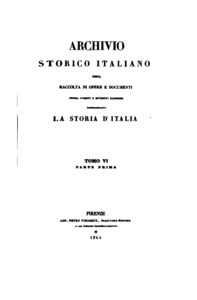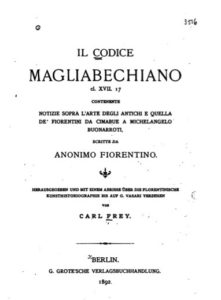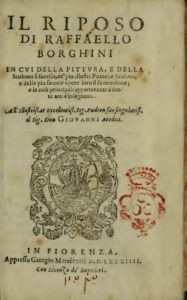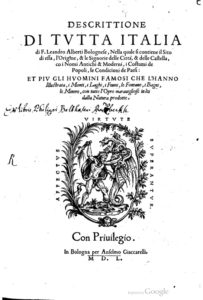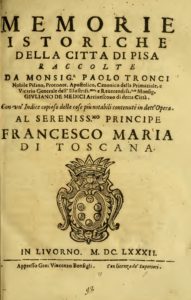
Paolo Tronci writes about the power of the earth in the Camposanto and how the earth got to Pisa. He also says that the holy earth was spread out next to the church of S. Giovanni al Gaetano and that it has the same ability to decompose bodies in a very short amount of time. Then he goes on to describe in quite a bit of detail how the Camposanto was built, mentioning the materials that were used. He describes the building accurately and also mentions the paintings and the sculptures one can find inside the cemetery. His description of the paintings is quite extensive although very selective. But he does write about the painting of Hell and the Triumph of Death, for example. He mentions several painters and gives some information about their lives and the works they painted.
Part1-3_Tronci, Memorie IstoricheEdition: Paolo Tronci, Memorie Istoriche della Citta di Pisa, ed. Giovanni Vincenzo Bonfigli and Vittorio Mancini
Uberti (Livorno: Bonfigli, 1682), 159-160.
Transcription
“[1200] Mentre che i Secolari attendevano alle fabriche da guerra, gli Ecclesiastici ancora diedero principio ad un edifizio di bellezza singolare, poiché l’Arcivescovo Ubaldo Lanfranchi diede mano alla fabrica del Campo Santo per la sepoltura de’ morti, la quale fù poi ridutta a perfezione con quella magnificenza, che fà stupire chi la vede, e considera, l’anno 1277 per la parte però che risponde verso il Duomo, come in detto anno si vedrà. Dicesi, che la sua lunghezza, larghezza et altezza corrisponda all’Arca di Noè, nel che io mi rimetto alla verità. Il suo pavimento è tutto di marmo fino bianco, con numero grande di sepolture in modo, che sotto ogni quadro vi è la sua; sebene non v’è fatto il chiusino di sopra. Sonovi di più molte tombe, ò pile, come vogliamo dire, pure di marmo bianco lavorate con intagli, e figure accomodate à torno àtorno nello scoperto. Le facciate de’ muri di dentro tutte sono dipinte di mano di valentissimi Pittori di que’ tempi, con molte historie del Testamento vecchio, e vite di Santi, e processioni con Reliquie trasportate a Pisa. Nelle parti, che guardano al Campo santo sono sessanta finestre di marmo con sottili colonne, dove furono già invetriate colorite con bellissime figure. La facciata per di fuori è tutta di marmo bianco con due belle porte et è coperto il detto edificio tutto di lastre di piombo. Si disse alcuni anni indietro, che la Terra Santa, della quale è ripieno il detto Cimiterio fosse stata portata dai Pisani, quando tornorno di Palestina. Altri vogliono, chehavendo inteso il sopradetto Arcivescovo Ubaldo, che di Gerusalemme era stata portata à Roma della terra dell’Orto, nel quale fù sepolto Nostro Signore, che in spazio di tre giorni consumava i cadaveri, risolvesse anch’egli di farne venire tanta, che riempisse lo spazio dello scoperto, e che mandasse navigli in Oriente con grandissima spesa, quali tornati con la terra medesima, la facesse spargere nel Cimiterio, e l’effetto, che ne segue, manifesta la verità.” (168-169)
“[1277] La sontuosa fabrica del Campo Santo in Pisa nel presente anno si tirò molto avanti come apparisce in un marmo murato nella facciata verso il S. Giovanni à mano manca nell’entrare per la porta principale, e sebene dice 78 s’intende al Pisano, e noi per concordare generalmente con i Scrittori, scriviamo al Romano. Dice l’iscrizione
Anno MCCLXXIIX, Tempore Domini Friderici / Archiepiscopi Pisani, Domini Tarlatti Potestatis, Operario Orlando Sardella, Ioanne Magistro aedificante.
Non restò per questo finito, e perfezionato in tutto il magnifico Edifizio sino all’anno 1464 in tempo dell’Arcivescovo Filippo de’Medici, come si legge in un’altra inscrizione pure in marmo nello stipite del portone incontro la Cappella della Barbaresca, hoggi de’ Battaglini, nella faccia, che mira verso il campo. Scrissi, mi raccordo, sopra nell’anno 1200 di questo medesimo Campo Santo in tempo dell’Arcivescovo Ubaldo, per confermarm con il Volterrano, hora mi dichiaro, che ammetto, che la fabrica si cominciasse, e che si mettesse in uso di servirsene per cemeterio, mà non già che allora di finisse, perché con pace dell’antico Scrittore, le inscrizioni convincono senz’ombra di falsità. L’edifizio in questo genere è così singolare, che non hà simile in tutta Europa. È fabricato tutto di marmi candidissimi, di lunghezza di braccia dugento tredici, di larghezza sessant’uno. Nel pavimento vi sono sepolture numero seicento trenta di marmi bianchi et accanto alla faccia del campo, vi sono circa sessanta cassoni pure di marmo historiati, parte de’ quali sono stati ivi trasportati da diverse parti del mondo. Vi sono altri sepolcri di famosi Dottori; Sonovi circa sessanta finestre pure di marmi con le colonnette simili con loro architravi intagliati. I tetti sono coperti di piombo, e le facciate de’ muri di dentro dipinte da squisitissimi Pittori, de’ quali m’ è parso bene additar l’opere, acciò siano note à chi hon ne avesse cognizione. Entrando però per la porta reale, e volgendo a man dritta, vi sono dipinte l’historie de’ Santi Padri heremiti da Pietro Laureati Senese, che fiorì circa gl’anni 1336. L’Inferno lo dipinse Bernardo di Cione Orcagna Fiorentino, che fiorì circa l’anno 1400. Segue poi il Giudizio universale, diptinto da Andrea Orcagna fratel maggiore del sopradetto Bernardo, e fiorirno le sue pitture l’anno 1389. Nella compsizione del detto Giudizio adattò molte bizzarie a suo capriccio, pose in una parte una rappresentazione de’ Campi Elisi, dipingendovi molti Signori involti in piaceri mondani, assisi sopra un prato fiorito sotto l’ombra de’ aranci, che facendo amenissimi bosco, hanno sopra i rami alcuni Amoretti, che volando attorno a molte dame dipinte al naturale, hanno sembianza di saettare i loro cuori et appresso d’esse son figurati huomini, che stanno attenti a suoni, e canti, e balli, fra essi vi è il ritratto di Castruccio Signore di Lucca giovane di bellissimo aspetto, con la veste, e capuccio azzurro, con uno sparviero in pugno, e tutti quei, che gli sono a acanto rappresentano altri Signori, che vivevano in quell’età. Nella medesima historia, figura sopra un’alto monte la vita di coloro che pnetiti de’ lor peccati, desiderosi di salvare le’anime loro, hanno lasciato il mondo, e ritiratisi ivi, dove sono molti santi Romiti, che servono à Dio, altri intenti alla contemplazione et altri alla vita attiva, e da basso v’è dipinto un S. Macario, che addita à tre Re, che à cavallo sono, e vanno a caccia, per accertargli delle miserie humane, tre altri Re morti, che giacciono in sepultura non ancora del tutto consumati, in uno de’ vivi à cavallo è ritratto Uguccione della Fagiuola, che si tura il naso per non sentire il puzzore de’ morti. Nel mezzo di questa historia vi è il trionfo della Morte. Vola ella per aria vestita di nero con la falce in mano, dimostrando, che con essa hà levato la vita a molti, che giacciono per terra estinti d’ogni stato, e condizione, giovani, vecchi, maschi, e femine d’ogni età, intorno a i corpi de’ quali sono alcuni diavoli, che cavano loro di bocca l’anime, e le portano a certe bocche che vomitano foco sopra la sommità d’un altissimo monte, dall’altra parte sono Angioli, che tengono una cartella grande, dove sono scritte queste parole: Scherno di sapere, e di richezze, e di nobiltade ancora, e di prodezze, val niente al colpo di costei; il resto non s’intende. Nella storia del Giudizio si vede Giesù Christo sopra le nuvole in mezzo à dodici Apostoli, e disotto da una parte i doloris effetti de’ dannati, strascinati da’ Demonj furiosamente all’Inferno, e dall’altra il giubilo de’ buoni, che da una squadra di Spiriti beati guidati da S. Michele Arcangelo sono condotti alla destra per anda a goder la gloria Celeste.
Buonamico Buffalmacco dipinse ancor lui in Campo santo un due luoghi, e per caminare con l’ordine, che habbiamo preseo, v’è di suo la Passione di Christo con numero grande di figure a piedi et a cavallo, tutte in varie, e belle attitudini, la storia della Resurrezione, e l’apparizione a gl’ Apostoli. Fu quest’huomo non solo valente nella pittura, ma graziosissimo nel parlare, e faceto. Morì l’anno 1340 in Fiorenza nell’Ospedale di S. Maria nuova, e doppo la sua morte fù chi scrisse di lui questi due versi.
Ut MANIMVS nemo melius formasse figuras, / Sic poterat nemo vel meliora loqui.
[…]
Seguono dopoi altre opere del sopradetto Buonamico Bufffalmacco, che sono alcune storie dal principi del Mondo fino alla fabbrica dell’Arca di Noè et in capo alla parete dipinse un Dio Padre, che regge con le braccia i Cieli, e tutta la machina dell’Universo, ivi sono distinte le Gerarchie, i Cieli, gl’Angioli, il Zodiaco, e tutte le cose superiori, gl’Elementi, e finalmente il centro, e per empir i due angoli da basso, dipinse in uno S. Agostino, e nell’altro S. Tommaso d’Aquino. […]
Si trovano poi l’historie del pazientissimo Giob tenute da molti di Giotto Fiorentino, mà secondo il parere del Vasari, sono di Taddeo Gaddi suo discepolo, che fiorì nel 1350. E perché in due quadri non si conoscevano più le pitture, furno di nuovo dipinte da Giovanni Stefano Maruscelli.
Le historie de’ Santi Martiri Efeso, e Potito, con additare la traslazione de’ loro corpi di Sardegna à Pisa, sono di mano di Luca Spinelli Aretino, che fiorì dal 1380 al 1400.
Seguono poi quelle della vita, e miracoli di San Raniero Confessore Pisano, le disopra sono di mano di Simone Memmi Senese, che fiorì nel 1345 e quelle di sotto d’Antonio Veneziano nel 1380. Del sopradetto Memmi è ancora la Madonna Santissima Assunta, sopra la Porta reale.
Il Vasari vuole, che ancora Vittore Pisano, detto il Pisanello, dipingesse il Campo santo. Io che poco m’intendo di pitture, non saprei dire quale fosse opera sua, se però non havesse fatto qualche cosa nell historie di S. Raniero, e de’ Santi Efeso, e Potito. Mi rimetto a chi s’intende dell’arte.
Fra tutti sopradetti Pittori per il comun giudizio è data la palma a Benozzo […]” (234-237).
Translation
I must not forget to say that the Pisans, on their return from Soria, loaded large quantities of holy earth into their ships. Hence the name of the cemetery, which was built near the Cathedral with great expense and splendor. As will be said, there is, I believe, no such magnificent building for the burial of the dead in the whole world, which is rightly admired by everyone who sees it. And it is characteristic of this sacred earth that it decomposes the bones of the cadavers within a short time. Its transport [to Pisa] has been mentioned by Volterra, F. Leandro Alberti, and other writers. I have heard from the elders of the city that the ships loaded with the aforementioned land stopped on the banks of the Arno next to the church of S. Giovanni al Gaetano before entering Pisa, and that, either at the request of the Gaetani, lords of the church, or by the will of the captains, many baskets of this earth were brought to the door of the aforementioned church, and that this place, although narrow, serves as a cemetery, and has the same characteristics as the Camposanto.
[1200] While the seculars were busy constructing war buildings, the clergy began a building of unique beauty, since the Archbishop Ubaldo Lanfranchi put his hand on the construction of the Camposanto for the burial of the dead, which was then completed in 1277 for the part that responds to the Cathedral, and has a magnificence that astonishes those who see and contemplate it, as can be seen as of that year. It is said that its length, its width and its height are equal to Noah’s Ark, by which I speak the truth. Its floor is made entirely of fine white marble, with a great number of tombs, so that under each square there is one of its own, although the shaft cover is not present at the top. There are also many tombs, or tubs as we will say, also of white marble, worked with carvings and arranged with figures around the edges in the open air. The facades of the interior walls are all painted by the hands of very skilled painters of the time, with many stories of the Old Testament and with lives of saints and processions with relics transported to Pisa. In the parts facing the Camposanto, there are sixty marble windows with slim columns, colorfully glazed with beautiful figures. The external facade is entirely in white marble with two beautiful doors and the whole building is covered with lead panels. Some years ago, it was said that the holy land with which the cemetery is filled was brought by the Pisans when they returned from Palestine. Others, having heard from the aforementioned Archbishop Ubaldo, wanted earth to be brought to Rome from Jerusalem, from the garden where our Lord was buried, so that the bodies would decompose in the period of three days. He had decided to bring so much of it that it filled the entire open space and with great effort he sent ships to the East, which, having returned from the same land, spread it in the cemetery and the effect that follows reveals the truth.
[1277] The magnificent building of the Camposanto was already well advanced in that year, as it says on a marble plaque inscribed in the masonry on the opposite side of St. John on the left in the main entrance, although it says 78 according to the Pisans, but we agree with the writers and write it according to the Romans. The inscription reads:
In the year 1278, in the time of Lord Frederico / Archbishop of Pisa, of Lord Tarlatti, of Operario Orlando Sardella, of John the Master builder.
But it did not stop there, and the magnificent building was completed only by 1464 in the time of Archbishop Filipp de’ Medici, as can be read in another inscription in marble in the doorjamb of the main gate on the side facing the field of the Barbaresca Chapel, which today belongs to Battaglini. As I wrote according to how I remember, following the year 1200 the same Camposanto was begun in the time of Archbishop Ubaldo, confirming Volterra. Then the construction was started and it was used as a cemetery, however it was not finished, as I say now. Because, to agree with the ancient writers, the inscriptions are convincing beyond a shadow of doubt.
The building is so unique that there is nothing like it in all of Europe. It is built entirely of the finest marble and has a length of 213 fathoms and a width of 61. In the floor there are 630 tombs of white marble and next to the field there are sixty historic chests of pure marble, some of which were brought from all over the world. There are other tombs of famous doctors; there are about sixty windows, also of marble, with similar small columns whose architraves are carved. The roofs are made of lead, and the walls inside have been painted by the most excellent painters, and it seemed to me proper to discuss the works, so that they might be mentioned and made known to those who do not yet know them. Entering through the royal gate and turning to the right, one sees the Lives of the Holy Fathers painted by Pietro Laureati of Siena, whose heyday was around 1336. The Hell was painted by Bernardo da Cione Orcagna of Florence, who flourished around 1400. This is followed by the Last Judgment, painted by Andrea Orcagna, Bernardo’s older brother, whose painting was completed in 1389.
In the composition of the Last Judgment there is much bizarreness corresponding to his whims. In one part he represented the Elysian Fields. He painted many gentlemen engrossed in worldly pleasures sitting on a flowery meadow under the shade of orange trees that form a pleasant forest. On the branches there are many cupids flying around ladies painted according to nature who seem to have arrows in their hearts and near them are painted the men who turn their attention to the sounds, songs and dances. Among them is Castruccio, Lord of Lucca, portrayed as a youth with handsome looks and robe and blue hood and with a sparrowhawk in his fist. And all those depicted at his side are other lords who lived in that period. In the same story, on a mountain, he depicts the lives of those who have repented for their sins. Wishing to redeem their souls, they left the world behind and retreated to where there are many holy hermits who served God, and others who devoted themselves to contemplation and others to the active life.
Below is St. Macarius pointing to three kings on horseback and hunting; to ascertain the miseries of humans, three other kings are depicted in fact, dead and lying in the tomb and not yet completely decomposed. One of the men on horseback is Uguccione della Faggiola, who holds his nose to avoid smelling the stench of the dead. In the middle of this story is the Triumph of Death. She [Death] flies through the air, dressed in black and holding a scythe, showing that with it she has taken the lives of many who lie dead on the ground. The dead come from every state and condition: young, old, men and women of every age, around whose bodies are some devils who pull the souls out of their mouths and take them to the openings that spew fire over the top of a very high mountain. On the other side are angels holding a large sheet on which is written: a mockery of knowledge, wealth, nobility, and valor, are worth nothing in the face of her [Death’s] blow; the rest is nothing anyway. In the story of the Last Judgment, we see Jesus Christ on a cloud in the middle of twelve apostles. Below, on one side, there are the sad goings-on of the damned, dragged furiously by devils into Hell, and on the other, the good, rejoicing and led to the right by a team of blessed spirits led by the Archangel Michael, to rejoice in the glory of Heaven.
Buonamico Buffalmacco painted in the Camposanto in two places and to continue the sequence we have started, there is his Passion of Christ, with a large number of figures on foot and on horseback, all with different and beautiful attitudes, the scene of the Resurrection, and Christ Appearing to the Apostles. This man was not only gifted in painting, but also most splendid in speech and appearance. He died in Florence in 1340 in the hospital of S. Maria Nuova, and after his death these two verses were written about him:
As no one created better pictures / No one was able to speak better.
[…]
Then follow other works by the aforementioned Buonamico Buffalmacco, which are stories from the beginning of the world to the building of Noah’s Ark. At the top of the wall, he painted a God the Father holding the sky and all the machinery of the universe within his arms. There are the hierarchies, the heavens, the angels, the signs of the zodiac and all superior things, as well as the elements, and finally the center, and to fill the two lower corners he painted two angels as well as St. Augustine and St. Thomas Aquinas. […]
There is also the story of the patient Job, attributed by many to Giotto of Florence, but according to Vasari, it is by Taddeo Gaddi, his disciple, whose heyday was around 1350. And because the painters of two paintings were no longer known, they were repainted by Giovanni Stefano Maruscelli.
The stories of the Holy Martyrs Ephesus and Potitus with the transfer of their bodies from Sardinia to Pisa are by Luca Spinelli Aretino, who flourished between 1380 and 1400.
These are then followed by the life and miracles of St. Ranieri, the Pisan confessor. The upper ones are by Simone Memmi Senese, who flourished in 1345. The lower ones are by Antonio Veneziano from 1380. The Madonna Santissima Assunta above the royal entrance is also by the aforementioned Memmi.
Vasari says that Vittore Pisano, called Pisanello, painted the Campo Santo. I, who do not know much about painting, would not be able to characterize his work if he had not done something of the story of St. Ranieri and the saints Ephesus and Potitus. I defer to those who know about art.
Among all the painters mentioned above, according to the general judgment, the prize must go to Benozzo […].

